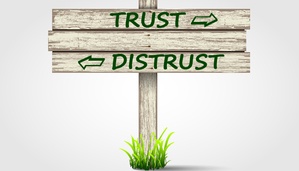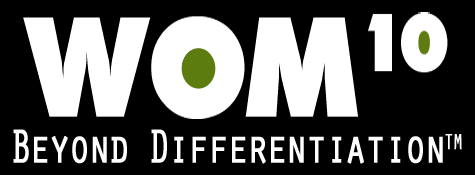 Trust is possibly the most powerful word an organization can have today. Either you have it with your customers (and employees) or you don’t. It isn’t something that works on a “meter” where you have 60% trust and 40% distrust. And once you have it, you can make it stronger and deeper once you have established it with your customers. But organizations that aren’t trusted also communicate this very clearly to their customers…and customers respond to it in many different ways.
Trust is possibly the most powerful word an organization can have today. Either you have it with your customers (and employees) or you don’t. It isn’t something that works on a “meter” where you have 60% trust and 40% distrust. And once you have it, you can make it stronger and deeper once you have established it with your customers. But organizations that aren’t trusted also communicate this very clearly to their customers…and customers respond to it in many different ways.
When a customer has their first interaction with your business (doesn’t have to be a purchase) what is communicated during that “moment of truth” with them? Is it an interaction that causes them to feel like they can trust you or one that creates uncertainty and doubt about whether they can trust your organization? This is a critical question for every business to answer…and most have no clue they are sending one of these messages to their customers.
What causes companies to send a message of DISTRUST?
Here are a few factors that cause a customer to stay suspicious about trusting your company…
- Employees ignore them upon first interaction…signaling they aren’t as important as other issues
- The employee tells them things as a way to get their attention that the customer instinctively knows aren’t true …if it’s too good to be true it usually isn’t
- Employees make quick promises and they either don’t keep them or the customer believes they can’t keep them
- Employees ask some “trapping questions” with the intent of making the customer feel stupid if they don’t answer yes…leading them to a close they don’t want
- Employees already have the answer…before asking any qualifying questions
These are just some of the ways that customers immediately start to distrust your employees or company. The easiest example is the “used/new car salesperson” or the “timeshare salesperson” or “mattress salesperson” and a host of other stereotypes we have created in our mind. If you walk into one of these businesses you immediately “have your guard up” because you have been programmed to not trust these people. You know they will lie to you to get a sale so you aren’t going to believe anything they tell you without doing more research.
While these are extremes, they are also reality in many businesses. Maybe not as dramatic as some of the ones I listed, but they are nevertheless ways to create distrust initially with customers. When companies do this (knowingly or unknowingly) they are starting “10 points behind” the competition because you have to “earn” your way back to zero. You have to earn your way back to the starting point where they are neutral in their evaluation of whether to trust you or not trust you.
Here’s another huge issue for companies…their competitors. What if you happen to be in an industry where many of your customers don’t trust your competitors? When this is the situation, often times you are lumped into the industry and “guilty by association” when it comes to trust. So regardless of whether or not you are doing the same things as your competition is doing, you are already distrusted. This is a very dangerous place to be…especially if one of your strengths is trust. Take the car dealer…what if you are one that your customers actually trust? You have an uphill battle because the industry is so polluted with unethical people…this is a much harder battle than many other industries.
What causes companies to send a message of TRUST?
Here are a few factors that cause a customer to immediately trust your company…
- Every employee greets them (with every interaction) warmly, sincerely, and in a way that demonstrates interest, not sales
- Employees immediately demonstrate an interest and caring for the person and their particular situation
- Employees start by asking sincere questions that demonstrate immediately that they care more about the customer than the sale
- They use simple words throughout to demonstrate they truly care…word like “help” and “please” and “thank you” and “resolving their issue/pain” and many others
- Employees offer an experience that clearly demonstrates they care about the customer…whether or not they sell them anything or not
- Leadership creates “different messaging” that causes the customer to break the “mind map” of the unethical companies to start fresh and see the difference
These are just a few of the ways that companies can create an environment of trust (almost immediately) with their customers. When an employee is tasked with HELPING rather than SELLING they come from a different place. They are armed with different tools to work with customers. And the customer can feel, sense, and recognize this difference. If you don’t believe me, stop reading this as the leader of your company and go back and read this as a CUSTOMER and see if this isn’t how you would feel after reading both lists again. There…now you are in the right mindset.
TRUST is so incredibly valuable today…it can make or break a business.
An example near and dear to me is when I worked for Arthur Andersen. I spent 8 years with the firm and they were incredibly wonderful years…I really loved working for this company. I left before their downfall so I wasn’t there to experience the catastrophe first hand. However, when I worked for them they were one of the most trusted, ethical, and upstanding accounting/consulting firms in the world. Then something happened called Enron that immediately caused the public to DISTRUST them…the rest is history. Even when only a few were unethical, it took down the largest firm of the Big 5 because of one simple word…TRUST.
Losing trust is even more critical today and it can happen in an instant. Losing it can take your company down before you even realize it. I believe it is one of the greatest RISK FACTORS that exist for companies today more than anything else. You can have a faulty product and replace it and survive. You can deliver substandard services and immediately improve them and survive. But if you LOSE THE TRUST of your CUSTOMERS and EMPLOYEES…you are gone.
I would encourage every business leader to do a TRUST ANALYSIS of their company…starting with your customers. If you’re not sure how to go about this, give me a shout and I can walk you through what this might look like for your company in your industry (B2C or B2B or non-profit). Regardless of how you do it, do it. Find out what the TRUST FACTOR is for your organization.
If it isn’t where you want it to be, FIX IT IMMEDIATELY. Create a strategy and plan to remedy this ahead of all your other initiatives. This has some incredible OPPORTUNITIES embedded in it to really help you understand where you are with your customers. It will show you where you stand in relation to your competitors and it will give you a clear roadmap of what you want to address in the short term as well as the long term for your business.
Change the TRUST EQUATION and you will see some incredible rewards for your business. And the biggest area you can change to create this impact is your CUSTOMER EXPERIENCE. Once they see you truly care about them…even OBSESS OVER THEM you will see a marked difference in their level of trust from the first interaction.
And here’s a bonus…CUSTOMERS TALK ABOUT THOSE THEY TRUST. They also TALK ABOUT THOSE THEY DON’T TRUST…a lot…and this is not what you want. Word-of-Mouth is more powerful today than ever in our history. What are your customers going to say to other potential customers? Are they going to say they TRUST you or DON’T TRUST you…it’s a matter of survival in today’s Revolution.
